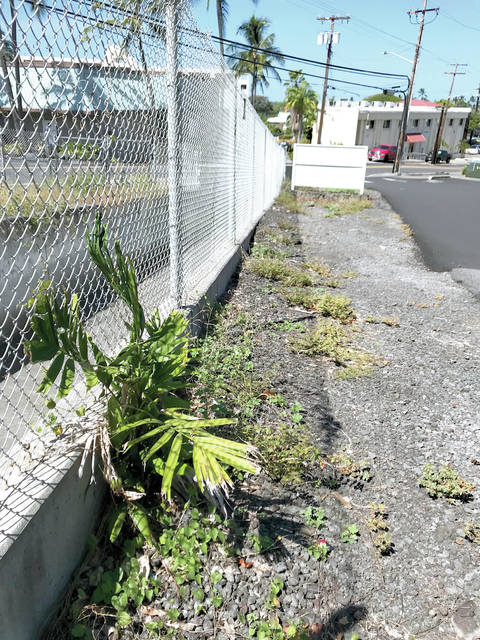Do you ever feel like giving up on your lawn and paving the whole thing?
Of course you have, but let’s face it, it’s not practical.
Your neighbors would probably tar and feather you. Not only that, but you would not be really happy even if they didn’t.
Your yard would look like a desert and feel like one, too. Besides, the idea is to plant more trees, shrubs and turf to improve our environments. Some communities such as Kailua-Kona are due major landscape face-lifts since water restrictions and minimal landscape maintenance have taken their toll.
Whether a small garden, shopping center, public street or community, it is time to make the effort to improve or little bit of the world.
If you fertilized and mowed your lawn properly, you might still have some trouble spots. Those areas that are too shady or too heavily trafficked need to be handled in some other way than turf.
Shady spots might be ideal for a small terrace, a paved area where you can sit and enjoy the cool location. If this is not practical in your landscape, then shade-loving ground covers or shrubs might be used.
When it comes to heavy traffic areas, a good solution is a walkway. Walkways are as much a part of a garden as are grass, shrubs and trees. As with the rest of the garden, walkways should be carefully designed. They also must be practical.
As a general rule, a walkway should go somewhere. It should serve a purpose. A walkway from the sidewalk to the front door is an example of a walkway with a purpose. However, the purpose is not served in a practical way if the walkway is designed to follow a crazy curve throughout the lawn. On the other hand, if the walkway is made to curve about a group of trees or go round a clump of shrubbery, or a water element, then the design serves a purpose.
A walkway to the front door, from the kitchen door to the rubbish bins, or a walkway around the house as part of a service entrance are all examples of walkways that have a useful purpose.
But landscape architects sometimes design walkways that are useful in another way.
One practice is to run a walkway about the border of the lawn, separating the grass from the shrubbery along the lot line. In one corner, the walkway might bulge out into patio size for chairs and perhaps an outdoor barbecue.
The walkway might serve as a mowing strip or limit the borders of the plant beds. It can provide a comfortable way to stroll through the garden to enjoy plants from a close-up viewpoint. If there are small children, it can even provide a safe tricycle run. In some cases, the walkway might end up going nowhere, but give a sense of depth to a small garden.
When we speak about paved walkways, drives or patios, materials that usually come to mind are stone, concrete and other pavers of various materials. They are durable and extremely versatile.
Concrete comes in many textures and colors and can be designed in many ways. For example, large stepping stones, 16-by-16 or 20-by-20 inches, can be used very effectively for making walkways. Zoysia grass can be grown between them, or the grass that is used for planting the lawn. This discourages unwanted skate boarders.
Leveling the ground where stepping stones are to be placed is very important, but if the area is filled with large roots, the stones will soon be tipped one way or another by the expanding roots. Individual stones can be pried up and the roots cut.
For leveling, one of the best materials is fine sand or cinder. Level, pack, moisten, let dry and pack again. Then place the stones.
The design of walkways should be thought out carefully and sketches should be made before any work is done. Planning done well in advance will save labor, excessive costs and, above all, disappointment.
Do not overlook the many other materials available here.
Brick is attractive and versatile but somewhat more expensive than textured concrete. Asphalt can be used and is cheap but not as durable.
Pine bark, macadamia nut shells and other organic materials are used for a very rustic effect, but it must be replaced to compensate for breakdown. Natural lava stone can be used if you can find the right shapes and sizes.
For some really exciting ideas, some excellent books are available at local garden shops. Sunset’s “New Western Garden Book” and Sunset Magazine, among others, might give you some good ideas.
If your project is a major one, our island has many landscape architects and landscape designers to assist you.

